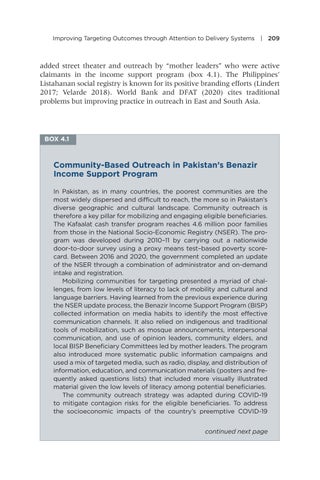Improving Targeting Outcomes through Attention to Delivery Systems | 209
added street theater and outreach by “mother leaders” who were active claimants in the income support program (box 4.1). The Philippines’ Listahanan social registry is known for its positive branding efforts (Lindert 2017; Velarde 2018). World Bank and DFAT (2020) cites traditional problems but improving practice in outreach in East and South Asia.
BOX 4.1
Community-Based Outreach in Pakistan’s Benazir Income Support Program In Pakistan, as in many countries, the poorest communities are the most widely dispersed and difficult to reach, the more so in Pakistan’s diverse geographic and cultural landscape. Community outreach is therefore a key pillar for mobilizing and engaging eligible beneficiaries. The Kafaalat cash transfer program reaches 4.6 million poor families from those in the National Socio-Economic Registry (NSER). The program was developed during 2010–11 by carrying out a nationwide door-to-door survey using a proxy means test–based poverty scorecard. Between 2016 and 2020, the government completed an update of the NSER through a combination of administrator and on-demand intake and registration. Mobilizing communities for targeting presented a myriad of challenges, from low levels of literacy to lack of mobility and cultural and language barriers. Having learned from the previous experience during the NSER update process, the Benazir Income Support Program (BISP) collected information on media habits to identify the most effective communication channels. It also relied on indigenous and traditional tools of mobilization, such as mosque announcements, interpersonal communication, and use of opinion leaders, community elders, and local BISP Beneficiary Committees led by mother leaders. The program also introduced more systematic public information campaigns and used a mix of targeted media, such as radio, display, and distribution of information, education, and communication materials (posters and frequently asked questions lists) that included more visually illustrated material given the low levels of literacy among potential beneficiaries. The community outreach strategy was adapted during COVID-19 to mitigate contagion risks for the eligible beneficiaries. To address the socioeconomic impacts of the country’s preemptive COVID-19 continued next page
